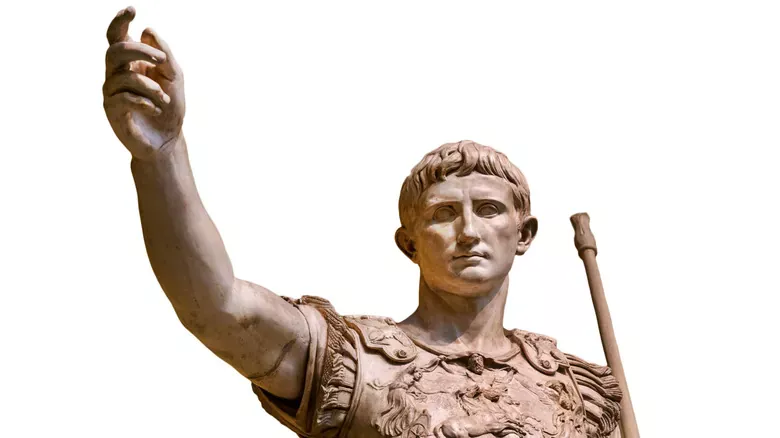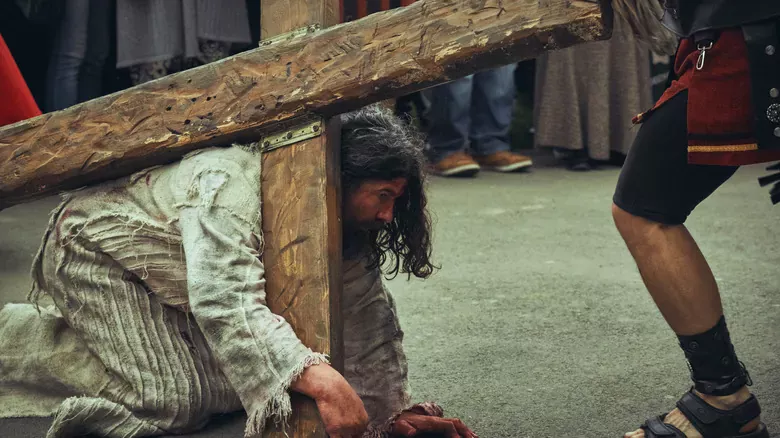More than 2,000 years after his birth in a humble manger, Jesus of Nazareth has a following of 2 billion people, according to OpenMind BBVA. While followers of Christ today don’t need historical proof of his existence for their faith-based beliefs, biblical scholars have long scoured the archaeological and historical records for evidence nonetheless.
The result? There’s a “broad and deep consensus among scholars” of Jesus’ actual existence based on both Christian and non-Christian textual evidence from the first century A.D. onward. Or, as Byron McCane, historian and archaeologist of religions and Judaism at the Atlantic University of Florida, puts it, “I do not know, nor have I heard of, any trained historian or archaeologist who has doubts about his existence.”
Among non-Christian references to Jesus are those by the Jewish historian Flavius Josephus and Roman authors like Pliny the Younger, Lucian, and the Babylonian Talmud (via Be Thinking). There’s also the Alexamenos Graffito, a piece of graffiti which dates to A.D. 200 and contains the earliest surviving depiction of Jesus.
Created by a Roman pagan, the graffiti mocks Christianity, providing further evidence of early Christians’ persecution in the Roman Empire. As reported by Smithsonian Magazine, events mentioned in the New Testament have been further bolstered by the recent find of a first-century synagogue like those where Jesus began his ministry.
Jesus pioneered the art of peaceful resistance

Jesus preached a form of peaceful resistance that often gets misinterpreted. Most people think of Jesus as synonymous with “turning the other cheek.” But the rabbi from Nazareth taught powerful lessons about resistance. Jews suffered under Roman rule in Palestine, and the people remained fractured about how to confront the situation.
Some chose to live by the sword as Zealots or assassins known as Sicarii, according to PBS. Others, like the Essenes, fled to caves where they copied and preserved the Dead Sea Scrolls. Still others, like the Pharisees and the Sadducees, attempted to maintain leadership roles and prestige by cooperating with the Roman authorities to various degrees. What advice did Jesus have for people living through these tumultuous times? According to Dr. Walter Wink, Christ advocated for peaceful resistance.
Wink notes that Jesus specifically references getting slapped on the right cheek, which implies the slapper used the back of his right hand. (Remember, in this culture, the left hand was reserved for unclean tasks like going to the bathroom.) But what would happen when the slave (instead of cowering and submitting) turned the other cheek? It would force the person committing the violence to use the back of their left hand. In other words, it would cause the slapper to admit their action was unclean. As Short Daily Devotions notes, using the back of the left hand was “associated with weakness and even impurity.”
He wasn’t trying to start a new religion

Friedrich Nietzsche argued, “In truth, there was only one Christian and he died on the cross” (via Goodreads). While a profound and pithy statement, Nietzsche’s wrong, and so are others who assume Jesus identified as Christian. Jesus came from a Jewish family and taught as a rabbi.
He didn’t talk about starting a new religion, and he kept the Mosaic laws, feasts, and traditions of Judaism, as his family had for generations. As reported by PBS, “to say that he was a Jew is saying a truism, is simply stating an idea that is so obvious on the face of it, one wonders if it even needs to be said. But, of course, it does need to be said because we all know what happens later in the story, where it turns out that Christianity becomes something other than Judaism.” We also know that historians such as Josephus referred to the followers of Jesus as being from the “tribe of Christians” (via UNC Charlotte). And these believers called themselves followers of “the Way,” per Catholic Online.
PBS points out that the early message of Jesus requires viewing through the lens of first-century Judaism. What’s more, “Behind the confrontations between Jesus as Rabbi and the representatives of the rabbinical tradition, the affinities are nevertheless clearly discernible in the forms in which his teachings appear in the Gospels.”
His name wasn’t Jesus

Putting Jesus in the proper Jewish historical context proves vital to understanding his message. As widely known as the name “Jesus” is, if you could travel back to first-century Roman Palestine, nobody would know who you were talking about if you asked for “Jesus.” Why? Because this name comes from the Greco-Roman “Iesous.”
But in Hebrew, it’s Yeshua/Y’shua. Meaning “to deliver” or “to rescue,” it provides a new perspective on this historical figure. It also proved a popular name during this time, providing more credence to this fact. How common? Archaeologists have discovered the tombs of 71 people named Yeshua. There are 30 references to the name in the Old Testament, concerning four different characters, per Slate. Hundreds of references to Yehoshua (Joshua), the name of the famed leader of the siege of Jericho, also appear.
While some people might see this as a contentious issue, it’s really “more of a translation issue” (via All That’s Interesting). That said, we’ve got to cut the first translators of the New Testament some slack. After all, modern languages such as Spanish, French, and English didn’t exist yet. What about Jesus’ last name? It wouldn’t have been “Christ,” a title that translates as the “anointed one” or king. Contemporaries of Jesus either used their father’s name or their home region to denote their identity. So, he would’ve gone by Yeshua Nasraya (Jesus of Nazareth) or Yeshua Bar Yehosef (Jesus, son of Joseph).
Jesus died as a rebel against Rome

Quite frankly, the Romans didn’t give a rat’s you-know-what about Jesus’ teachings, per Newsweek. And being accused of blasphemy by the Jewish Sanhedrin also meant little to them. So, how did Jesus end up crucified by the Roman Empire? On charges of sedition because of his teachings about the “Kingdom of Heaven.” Crucifixion was so brutal that only non-Roman citizens got punished this way. It represented the Romans’ ultimate political weapon, instilling terror in anyone who thought twice about sedition.
As bestselling author Stephen Mansfield puts it, crucifixion represented “an act of state terror.” The Roman Empire tested many other torture methods before stumbling on this horrific form of punishment, trying everything from stoning to strangling, burning to boiling in oil. But what made them settle on crucifixion for so many Jewish men of this time? It sent a lingering, painful, and very visual message.
How did this nasty practice get started in the first place? According to Live Science, it likely began with the Assyrians or Babylonians. By the sixth century B.C., the historical record shows that the Persians also practiced crucifixion. But these punishments occurred on trees rather than wooden crosses. The later development of the wooden cross came thanks to the uber-organized Romans. But how did they stumble across this punishment, especially considering their lack of interaction with the aforementioned Assyrians, Babylonians, and Persians? During the third-century-B.C. Punic Wars, when they fought against Carthage.
Jesus was far from the only Jew to face crucifixion

Many New Testament readers focus on the back-and-forth banter between Jesus and the Pharisees, but another tension underlies these texts: the Roman oppression of the Jewish people (via PBS). Crucifixion represented a clear and present danger for all Jewish men. Many thousands would perish on the cross over the centuries. First-century Jewish historian Josephus wrote, “I saw many captives crucified, and remembered three of them as my former acquaintance” (via UNC Charlotte). The Romans perfected this horrific torture to inflict ultimate pain and humiliation, and it persisted unheeded until the fourth century A.D., when Constantine I ended the practice, according to Live Science.
As Jeremy Ward of Kings College London put it (via Newsweek), “Crucifixion was a method of torture — not just putting to death. It was a particularly cruel and unusual form of disposing of people. Each aspect of death on the cross had its particular ghastliness.” Ward noted that studying the bones of a crucified man (located in a museum in Israel) made this clear. To the surprise of researchers, they determined that nails had been driven through the heel of each victim’s foot. Their conclusion? Instead of stacking the feet, as seen in so many artistic depictions, executioners affixed the feet with each ankle on one side of the cross.
Jesus championed the rights of children

We take for granted the idea that children are the future. We celebrate their curiosity, innocence, and overall cuteness. But growing up in the Roman world remained a vicious and precarious endeavor. Not only did infants get routinely left out to die of exposure (especially if deemed deformed, weak, or girls), but selling them into slavery and prostitution proved commonplace (via HuffPost). In essence, minors had no rights.
For this reason, The Week argues that “Christianity invented children,” not only by protecting their lives but ascribing them with special worth. And it all started with Jesus’ teachings about kids. Besides setting a precedent for how children should be valued, the New Testament also spoke about the ancient world’s preponderance with overlooking and mistreating one of the world’s most vulnerable populations — little ones. As reported by World Vision, this lesson extended to all individuals facing abuse due to their class, identity, and background.
He hung out with the dregs of society

Jesus consistently taught about the importance of individual rights, and he stood up for oppressed members of society, per HuffPost. He gained a negative reputation among the religious elites of the day for rubbing elbows with lepers, sinners, sex workers, tax collectors, beggars, and Samaritans. In a time when rabbis wouldn’t help an injured person for fear of becoming “unclean,” Jesus set a rigorous standard of caring based on the concept that all people are equally important in God’s eyes (via the Biblical Archaeology Society).
He also earned a reputation for hanging out with the people society cast aside. According to Brad Chilcott, writing for The Guardian, “Jesus was overtly on the side of the poor, the excluded, the ignored, the disenfranchised and the exploited. He was on their side when it damaged his reputation, his earning potential and any hope he had of moving up the ranks of religious or political power. “
Jesus set a rigorous standard for the downtrodden and how they should be treated. (No wonder he ended up running afoul of the religious and political authorities of the region!) As argued by Chilcott, “[Jesus] was on their side when he drove out the price-manipulators and rent-seekers in the temple courts and he was on their side when it cost him his life.”
He stood up for the rights of women

Like children, women occupied the bottom of the social totem pole during Jesus’ time, per One for Israel. Nowhere did this prove more accurate than within the confines of first-century Judaism, where women got stoned to death for little more than accusations of adultery. But Jesus operated against the norm, addressing women regularly in public at a time when they remained generally ignored by men and treated as second-class citizens.
In the way he spoke to women (e.g., “daughters of Israel”), he afforded them spiritual equality with men, and he treated them as individuals with a “measure of self-determination” over their lives. As Crossway observes, “Jesus’ regard for women was much different from that of his contemporaries. … For Christ, women have an intrinsic value equal to that of men.” Why did he treat women so radically different than his first-century peers? Because he saw them as people first.
Jesus’ actions exemplified his belief system. He conversed with women in public, something many Jewish religious leaders would have avoided, and he made them a vital focus of his healing ministry. He collected a massive following of female believers and treated his mother with a level of respect and care not typical of his day (via the Jesus Film Project). The New Testament, inspired by his life and teachings, also placed a significant focus on women. The Book of Luke explores Jesus’ ministry, often from the point of view of the women around him.
Jesus made compassion cool

At this point, it’s not a surprise to say that compassion didn’t abound in the Roman Empire (via Christianity Today). In a world where fathers killed their kids (and even wives) without repercussions, a general lack of concern for those who suffered existed. The same goes for how the Roman government responded to times of plague and other catastrophic events.
But Jesus turned the paradigm on its head, advocating for rigorous care of fellow humans independent of the categories that so often condemned people in the ancient world (e.g., class, gender, and religious beliefs). According to HuffPost, Jesus’ teachings led to the establishment of treatment centers for lepers, which, themselves became the forerunners to hospitals.
Through his teachings and the examples he set working among the needy, he paved the way for charitable organizations. What’s more, he demanded an “alternative society” in his teachings concerning the “Kingdom of God,” which placed a premium on the value of human life and the celebration of fundamental civil rights.
He also made humility (and forgiveness) a thing

People talk about toxic masculinity today, but it’s safe to say most contemporary men have nothing on the ancients. Ancient Greeks, Romans, and Jews prized values like wisdom and courage, and humility fell nowhere in the mix. Men of the ancient world bragged about their accomplishments, whether warrior exploits or religious theatrics, as reported by the University of Cambridge. Against this unbridled bragging, Jesus’ exhortations to humility, whether serving the poor or washing feet, proved countercultural.
Historian John Dickson argues (via HuffPost), “It is unlikely that any of us would aspire to [humility] were it not for the historical impact of his crucifixion … Our culture remains cruciform long after it stopped being Christian.” The lessons he taught his disciples and the world regarding how to treat others would have lasting repercussions (via Owlcation).
The name “Jesus” remains synonymous with forgiveness, so it’s easy to forget that he taught to a world where forgiveness had no real utility. After all, the ancient world ran on the mantra of rewarding friends and punishing enemies. Far from the “high road,” this approach to life dominated everything. No wonder Hannah Arendt, the first female professor at Princeton, would write, “The Discoverer of the role of forgiveness in the realm of human affairs was Jesus of Nazareth.” While other examples of forgiveness exist before Jesus, one thing’s for sure: He made the idea not only famous but expected.
Jesus inspired Gandhi

According to the BBC, Gandhi drew inspiration to peacefully resist the massive British Empire by studying the life of Jesus, whom he called “one of the great teachers of mankind.” He wrote extensively about Jesus and felt deeply impressed by the fact that though “completely innocent, [he] offered himself as a sacrifice for the good of others, including his enemies” (via MK Gandhi).
Throughout his life, Gandhi claimed to be just as much a Muslim, Jew, Sikh, and Christian as a Hindu. He also kept one decoration on the mud wall in his hut, a black and white reproduction of Jesus with the inscription beneath it reading, “He is our peace.” It’s little wonder that the Sermon on the Mount profoundly impacted the Indian activist, providing him with a model of selfless and peaceful resistance.
The result? Will Durant, the historian and philosopher, says this of Gandhi’s esteem for the rabbi from Nazareth: “He did not mouth the name of Christ, but acted as if he accepted every word of the Sermon on the Mount. Not since St. Francis of Assisi has any life known to history been so marked by gentleness, disinterestedness, simplicity and forgiveness of enemies” (via RZIM).
A belief in Jesus is fundamental to Islam

Although people associate Jesus exclusively with Christians, he’s an important figure in Islam, along with his mother Mary and the angel Gabriel, according to Vox. Jesus, known as “Isa” in Arabic, was birthed by the Virgin Mary (the only woman mentioned by name in the entire Quran). And he grows to the position of a celebrated prophet mentioned 25 times in the Quran. For this reason, when his name is spoken, it’s followed by the phrase “peace be upon him.”
In these stories, he’s shown performing miracles and healings. What’s more, the Quran prophesies that Jesus will come back at the end of the world to defeat al-Masih ad-Dajjal (who Christians know better as the Antichrist). Of course, these realizations shouldn’t minimize fundamental differences between Christianity and Islam. After all, Muslims don’t consider Jesus the son of God, which represents a “critically important distinction,” as Vox puts it.
Nevertheless, the importance of Jesus to the Quran can’t be underestimated. According to Omar Suleiman, writing for the Religion News Service, “It is not an exaggeration to say that I could not be a Muslim without believing in Jesus. … While we Muslims fundamentally differ with our Christian brethren on the Trinity, crucifixion and salvation, our belief in Jesus is fundamental to our faith.”








